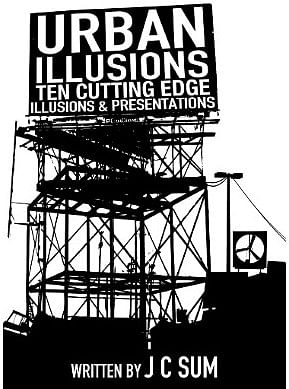Urban Illusions: Then Cutting Edge Illusions & Presentations by J.C. Sum
Reviewed by Jamy Ian Swiss (originally published in Genii November, 2011)

J.C. Sum is an illusionist from Singapore who is among today's' most successful large illusion performers in Asia. At 35 years of age, Sum's resume of commercial successes and media attention is impressive, a success that is doubt-less partly due to his performing partnership with "Magic Babe" Ning (That's her name. Hey, I'm just the reporter.)
Urban Illusions is the fourth book of illusions Mr. Sum has written since 2004 (apparently counting this one as a different book than the previous limited edition; one illusion included in that original has been cut from this version). While first published in 2004, the book has now been reis-sued in this new edition for wider distribution. It describes 10 illusions, some of which come from the author's actual repertoire (you can tell because there are photos of the actual props), while others are "prototyped," which is to say, they have been designed and described on paper. Here's an unreasonably brief rundown of the 10 illusions:
"Seven by Half V2.0": This is a vertical blade-through-girl, a la "Zig-Zag." but with six blades slicing the standing assistant horizontally, after which the top half of the box hinges over 90 degrees once all the blades are in. "Fortress": an imposing looking steel-framed take on the "Assistant's Revenge" illusion.
"Revollusion": This is a magical appearance of the magician standing immediately in front of a giant industrial fan; the implication is that he comes through the fan, but he does not actually begin on the other side, rather he simply and suddenly appears, close to the fan, from behind a cloth.
"Slicing Through": the illusionist walks through a narrow box, the inner side walls of which are covered with an array of jaggedly broken glass bottles. (The method is based on that of Scott Alexander's "Shattered," a commercial and practical approach to the mystifyingly popular hand-spiker routine.)
"DeKolta's Dilemma": A self-contained "DeKolta Chair" in which the chair is withdrawn from a wooden crate, set on the crate, and after the assistant vanishes from the seat, the doors of the crate are dropped to show that it is empty.
"Crystal Metamorphosis": An industrial looking version of "Metamorphosis" with transparent walls that provides for a rapid version of the classic exchange. (This is one of several illusions in which the finished prop is pictured, and which the author has used extensively.)
"VIP Trunk": This is one-step-further approach to the "Tip-Over Trunk" that provides for an easy production of a VIP client.
"Benchmark": A self-contained surrounded instantaneous appearance of an assistant.
"6 Inches": Passage of the illusionist from behind to in front of a large steel plate, apparently through a six-inch hole in its middle.
"Wind Passage": A method for the performer's passing through a giant industrial fan.
So, do any of those float your boat (or lady)? You won't find any radically new performance ideas. These are flash bang illusions, performed by a team who in 2009 set a world record for most number of grand illusions performed in five minutes namely, 15. (As if that's a good thing.) But considering the dearth of interesting illusion books these days, this one should at least be commended for possessing a reasonable degree of real-world pragmatism. The diagrams are sound, the measurements useful, and where precise measurements will not be sufficient, because the details must be worked out depending on choices of materials and other hands-on issues, the author at least says so.
The author also offers bits and pieces of real-world experience about how to construct and per-form such material. He pays his respects to his role models and inspirations, and gives credit where due. And he explains his rationale behind his thinking. Others might not always embrace his reasoning, but at least he provides it.
"Cutting edge," like "avant-garde," always strikes me as a term that, once invoked by someone about their own work, thereby provides instant assurance that the work is no such thing. Is a self-contained "DeKolta Vanishing Lady," or four more blades in a "Zig-Zag," cutting edge, or a step back? Well, that at least partly depends on taste, doesn't it? For which, as the saying goes, there is no accounting. Then again, we might argue that these issues go beyond mere taste, and can be argued more objectively than that. Some methods, and plots, are good, and some are decidedly not good, and the old saying that there's no such thing as a bad trick is utter nonsense.
But such artistic musings aside, here are 10 illusions from a relatively young but experienced working professional, who has some ideas about what it takes to be successful, and can and does explain why he uses 13mm honeycomb aluminum instead of plywood, and why illusions are better built to be transported without disassembling them entirely (an idea he credits to Chris Murphy of Oz Illusions). So while there's little doubt these illusions play big, the hell with packing flat.
The book is well produced, and printed on heavy glossy stock, well-suited to the crisp black-and-white drawings and blueprints. Is it worth the asking price of $90? Probably not to the casual reader or hobbyist. If a working pro puts one of these pieces into his act, it might well be. This is one of those purely subjective questions, the answer to which will be delivered when Mr. Sum discovers how much of his print run sells.
